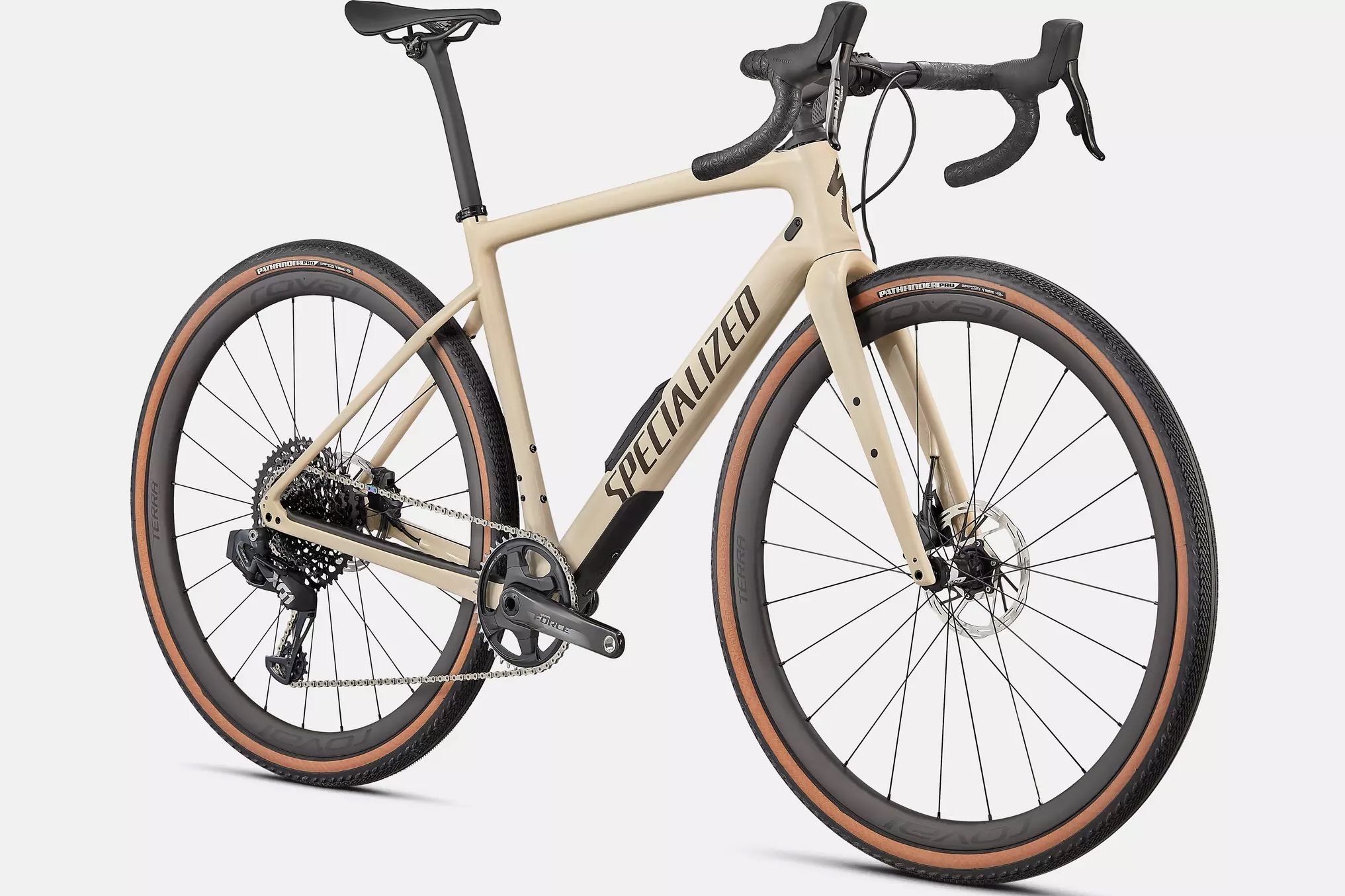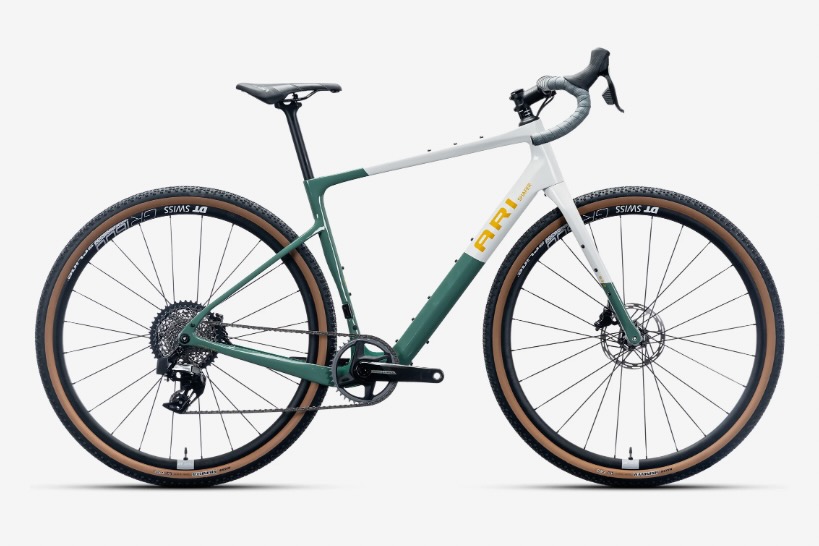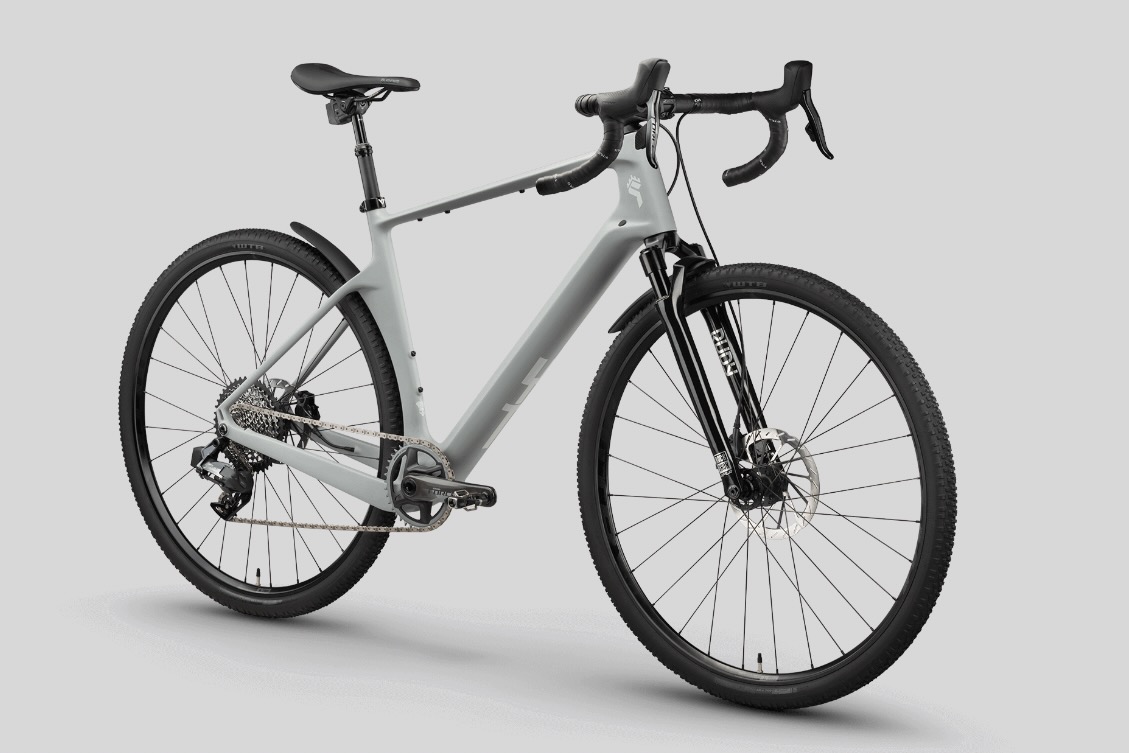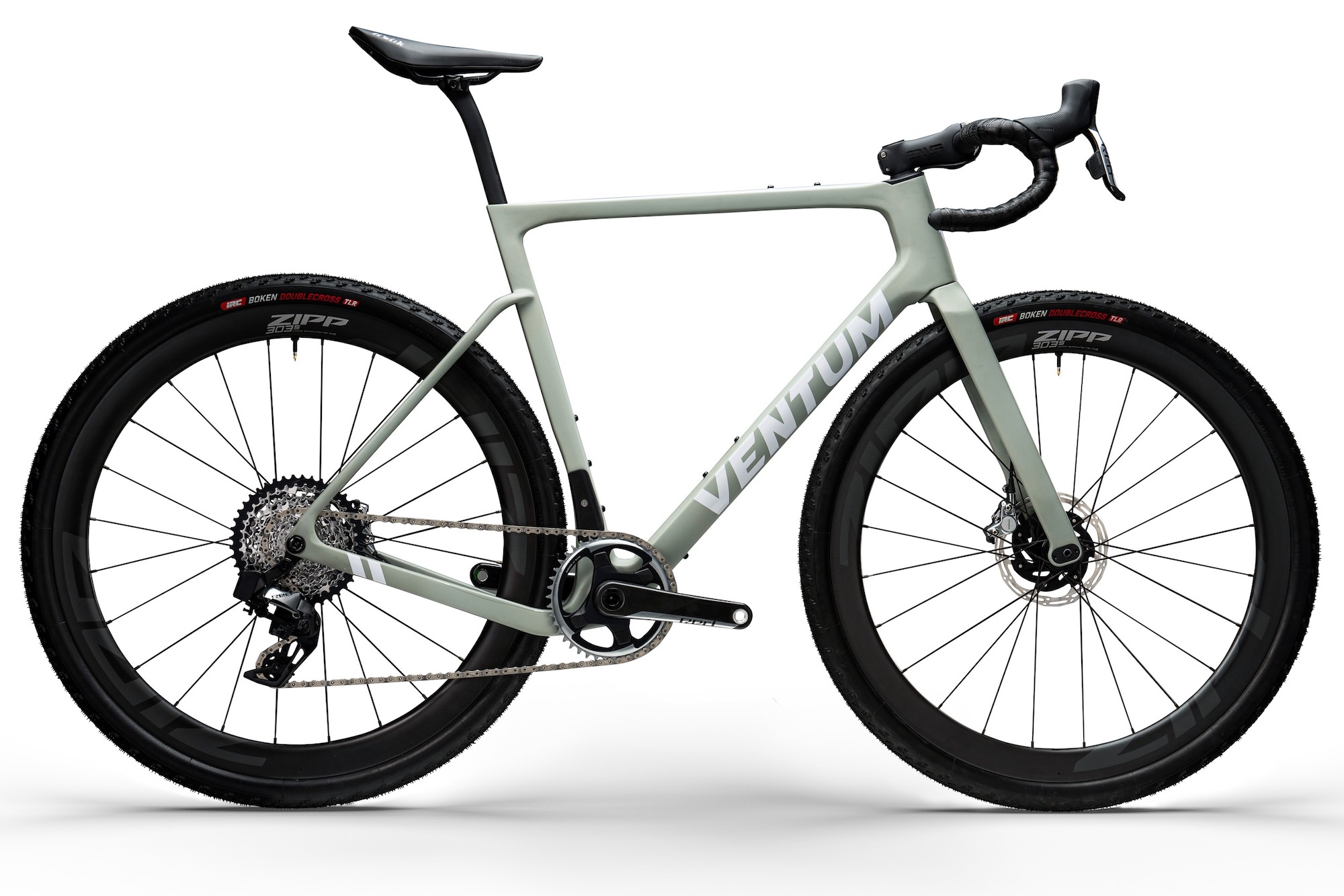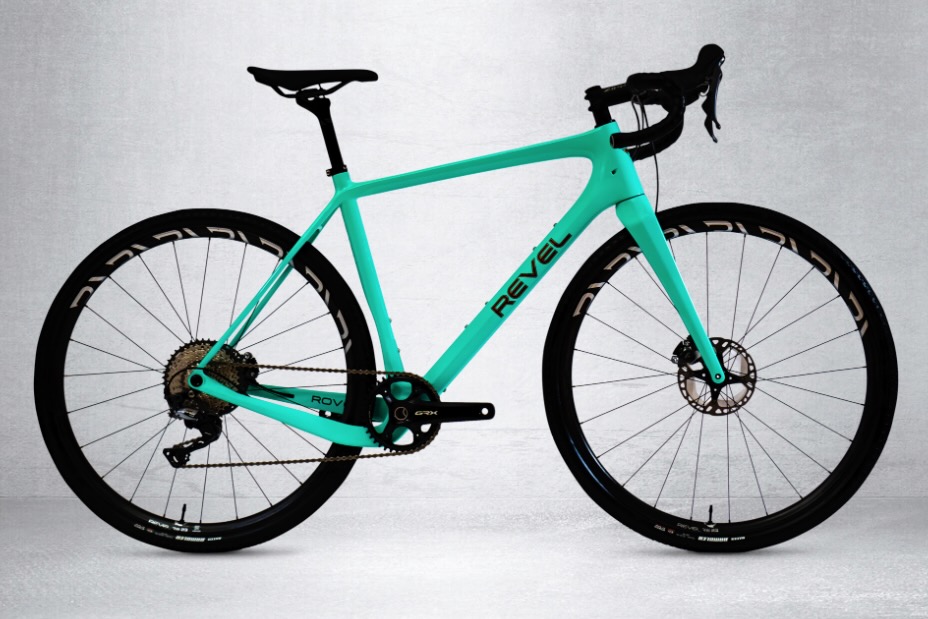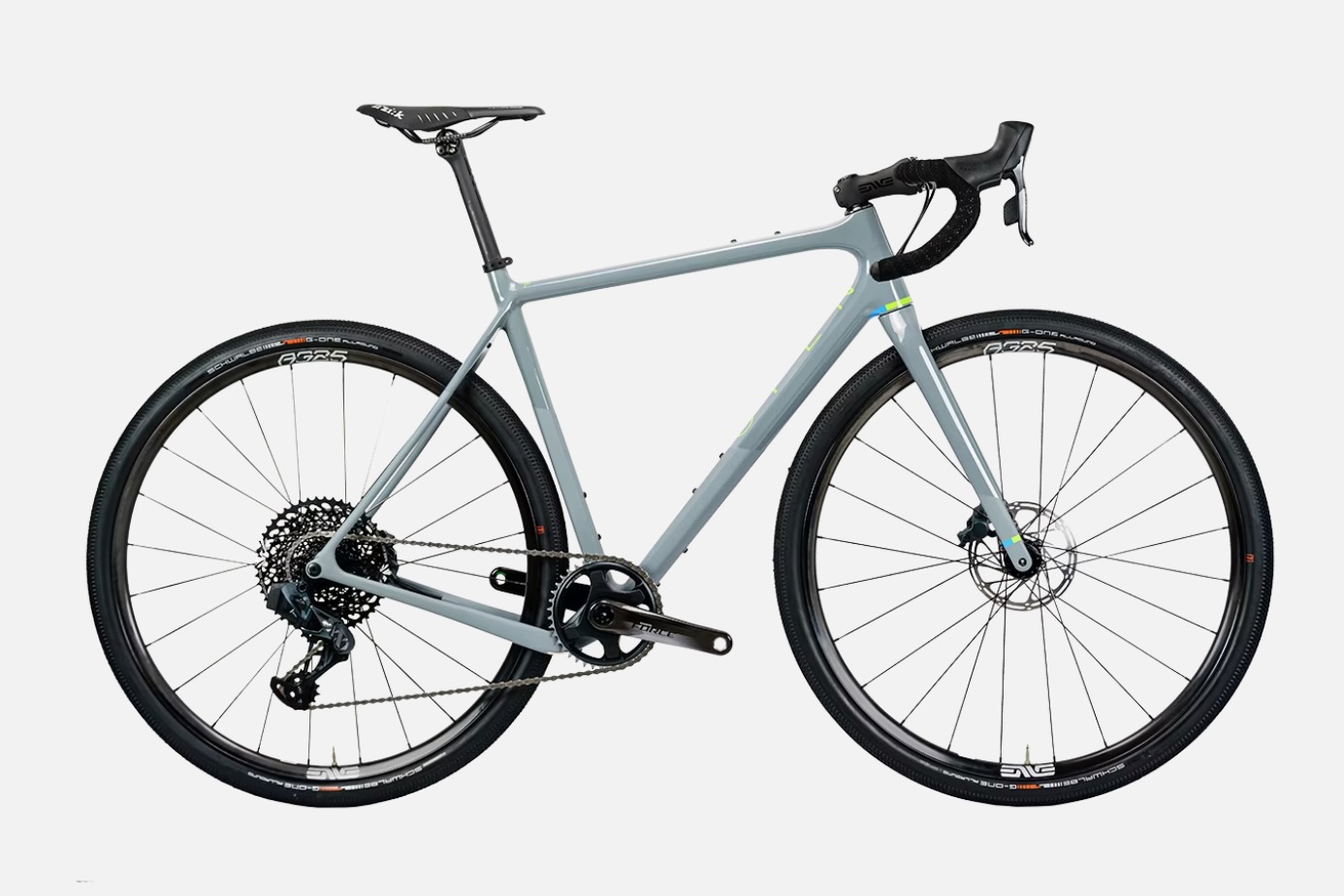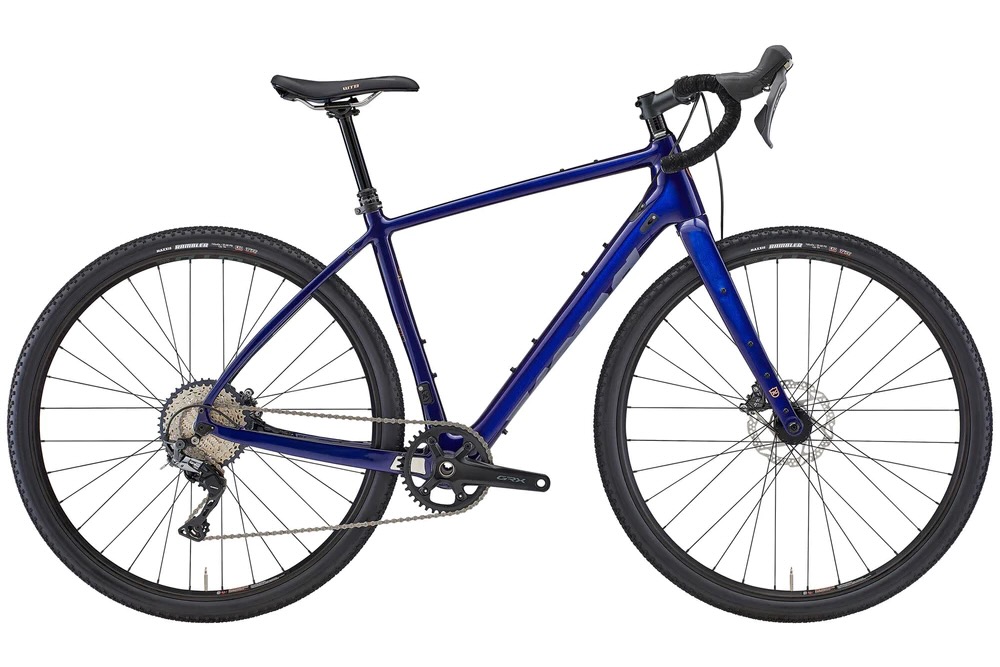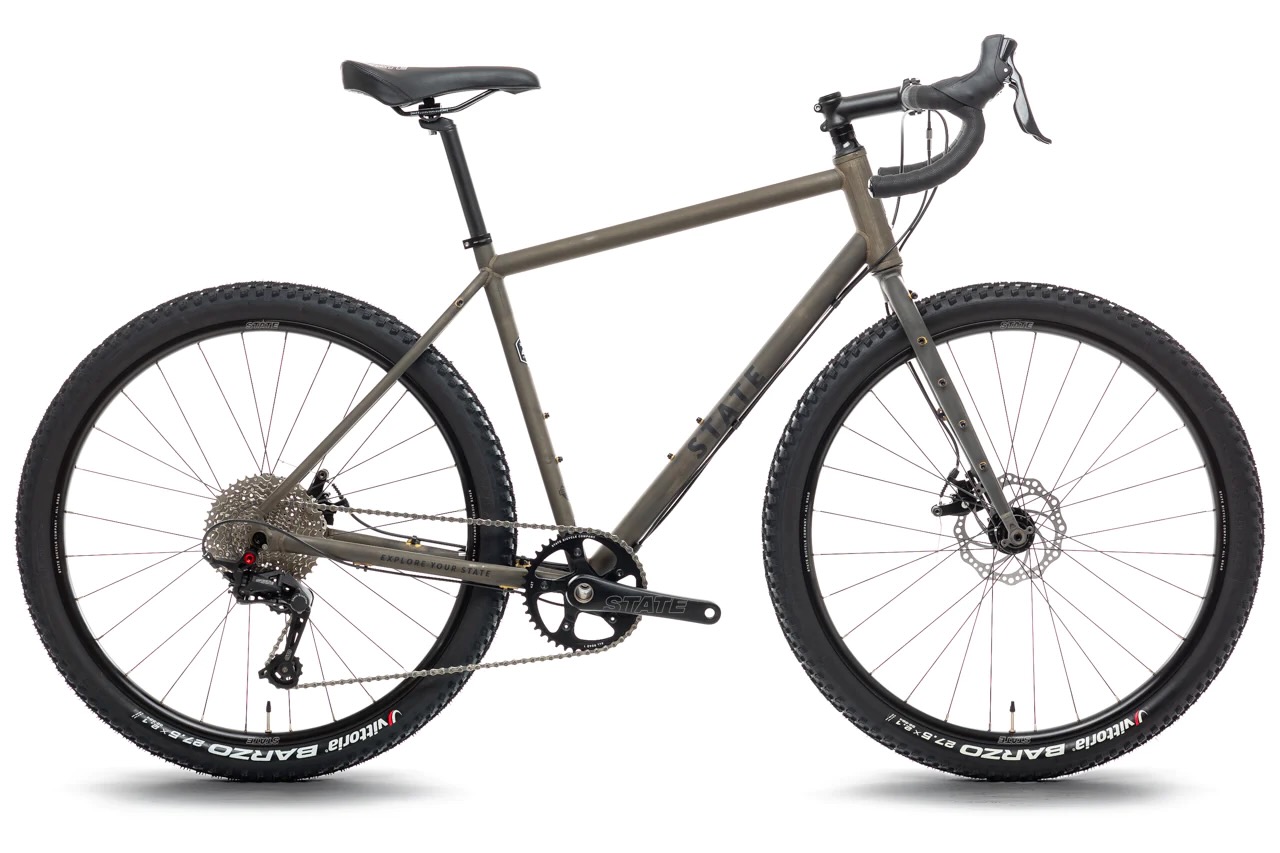As trails become more crowded and phones distract drivers on the road, riders are turning the pedals toward remote stretches of backcountry gravel. It’s arguably safer, makes you a better rider, and is undeniably fun.
While adventurous riders have been riding all manner of bikes on dirt roads for many decades, gravel biking has seen a recent explosion in popularity. The cycling industry has taken notice, and there are now loads of models on the market made specifically for gravel riding. But gravel riding is somewhat hard to define. It’s a choose-your-own-adventure kind of sport that includes everything from rough pavement to singletrack and every type of dirt road in between.
Gravel bikes have evolved from modified road bikes and cyclocross bikes into the machines we’re more familiar with today. Though they may look a lot like beefed-up road bikes, modern gravel bikes have increased clearance for larger tires, relaxed geometries, and some even come with front suspension and dropper posts. Today’s gravel bikes are capable, comfortable, and efficient across a wide range of terrain and surfaces.
With so many brands and models to choose from, finding the right gravel bike can be a challenge. Fear not, our team has been testing gravel bikes since 2021, and this list represents the best options we’ve tried so far. Whether you’re a seasoned gravel aficionado or just getting into the sport, we’ve got recommendations to suit your needs and meet your budget.
Editor’s note: We updated this guide on May 16, 2024, with the addition of five new models, including the value-packed Ari Shafer, the mountain bike-inspired YT Szepter Core 4, and the race-ready Ventum GS1. We also added information and photos to our buying advice to help readers when searching for their next gravel bike.
The Best Gravel Bikes of 2024
- Best Overall Gravel Bike: Specialized Diverge Pro Carbon
- Best Budget Gravel Bike: Ari Shafer Carbon
- Best Entry-Level Gravel Bike: State 6061 All-Road
- Best Gravel Bike With Front Suspension: YT Szepter Core 4
- Best Gravel Bike for Racing: Ventum GS1
- Best Gravel Bike for Bikepacking and Touring: Ritchey Outback
Specialized Diverge Pro Carbon
- Frame Material: Carbon fiber
- Weight: 20 lbs., 1 oz.
- Tire Clearance: 700c x 47 mm (tested); 650b x 2.1″
- Available Sizes: 49, 52, 54, 56, 58, 61 cm
Pros
- Future Shock 2.0 (giving the bike 20 mm of suspension)
- SWAT internal storage
- 700mm or 650b wheels
- Fantastic fit positions you “in” the bike
- Reach and slack is exceptionally comfortable
- Range of models/prices to choose from
Cons
- Expensive (but there are less expensive models)
- Upright geometry doesn't have the raciest feel
Ari Shafer Carbon
- Frame Material: Carbon
- Weight: 20 lbs., 2 oz.
- Tire Clearance: 700c x 50 mm
- Sizes Available: XS, S, M, L, XL
Pros
- Impressively versatile
- Great prices for complete builds
- Stable, comfortable geometry
- Plenty of bottle and accessory mounts
- Custom 23-point setup
- carbon wheel upgrades available
Cons
- Not the lightest
- No builds come with suspension forks
State 6061 All-Road
- Frame Material: 6061 Aluminum w/ carbon fork
- Weight: 21 lbs., 13 oz.
- Tire Clearance: 700c x 45c or 650b x 55c
- Sizes Available: XS, S, M, L
Pros
- Affordable – builds between $1,400 and $2,400
- Versatile all-around performance
- Carbon fork for chatter reduction and comfort
- Available as a carbon frame too
Cons
- Not super light but respectable for an aluminum frame
- Aluminum frames lack extra mounting options on top tube and underside of downtube
YT Szepter Core 4
- Frame Material: Carbon
- Weight: 21 lbs., 14 oz.
- Tire Clearance: 700c x 45 mm
- Sizes Available: S, M, L, XL, XXL
Pros
- Suspension fork and dropper post make for confident and comfortable descending
- Outstanding build for the price
- Stable at speed
- Comfortable geometry
- Integrated fenders
Cons
- Matte finish is harder to keep clean
- Heavier weight (still pretty light)
Ventum GS1
- Frame Material: Carbon
- Weight: 19 lbs., 2 oz.
- Tire Clearance: 700c x 48c
- Sizes Available: XS, S, M, M/L, L, XL
Pros
- Stable at speed but responsive to steering inputs
- Laterally stiff
- Lightweight
- Numerous mounting bosses
- A little less expensive than the comparable retail models
Cons
- Still pricey
- Direct-to-consumer model, so cannot test ride at a shop
- Not as compliant as adventure-oriented gravel bikes
Ritchey Outback (Frame Only)
- Frame Material: Ritchey Logic Steel w/ carbon Adventure fork
- Weight: 5 lbs., 10 oz. (frame and fork)
- Tire Clearance: 700c x 48mm or 650b x 2.0"
- Sizes Available: XS, S, M, L, XL
Pros
- Upright and tight position, yielding cockpit-like comfort in the saddle
- Classic mountain bike geometry is comfortable
- Versatility: Can run 700c or 650b with up to 2″ tires
- Carbon fork with bosses for cages
- Beautiful TIG-welded frame
Cons
- Long wheelbase puts tire behind the rider, causing the bike to lose traction on some sandy ascents
- Exposed cable routing can get in the way of many modern frame bags
- Definitely more biased toward touring and bikepacking
Best of the Rest
- Frame Material: Carbon fiber
- Weight: 19 lbs., 5 oz. (size L, custom build)
- Tire Clearance: 700c x 50 mm or 650b x 2.1"
- Available Sizes: S, M, L, XL, XXL
Pros
- Smooth ride for a carbon frame
- Excellent cornering characteristics
- Reasonable price for a high-end carbon frame
- Universal derailleur hanger for ease of maintenance
Cons
- Only compatible with 1x drivetrains
- No rack or fender bosses
- Frame Material: carbon
- Weight: 18 lbs., 6 oz.
- Tire Clearance: 700c x 46 mm or 650b x 61 mm (2.4")
- Sizes Available: XS, S, M, L, XL
Pros
- Upright and tight position, yielding cockpit-like comfort in the saddle
- Clean internal cable routing
- Geometry feels confident and fast on variable terrain
- Versatility. Can run 700s or 650b with up to 2.4″ tires
Cons
- “Crunched” cockpit may not fill all
- Can only run as a 1x
- Frame Material: Carbon
- Weight: 20 lbs., 5 oz.
- Tire Clearance: 700c x 45 mm
- Sizes Available: 50, 52, 54, 56, 58 cm
Pros
- You can throw this bike around with confidence
- Wide drop bars provide added stability
- Ample space in the stays for 650b wheels/tires
- Dropper seat post
- Reach and slack is exceptionally comfortable
- Lots of bosses to mount bottles and cages
Cons
- Stack height and slack won’t suit riders who prioritize speed over comfort
- Color may not appeal to everyone
- Stock wheels aren't amazing
- Frame Material: 4130 chromoly steel
- Weight: 27 lbs., 13 oz.
- Tire Clearance: 700c x 45c or 650b x 53c (2.1")
- Sizes Available: XS, S, M, L
Pros
- Very affordable pricing
- Many affordable upgrade options
- Comfortable and stable frame geometry
- Plentiful mounting bosses on frame and fork
- Steel frame big tires offer smooth ride
- Available with 700c or 650b wheels/tires
Cons
- Heavy
- Weak mechanical disc brakes (upgradeable)
Gravel Bike Comparison Chart
| Gravel Bike Model | MSRP | Frame Material | Weight | Tire Clearance | Sizes Available |
|---|---|---|---|---|---|
| Specialized Diverge Pro Carbon | $8,200 | Carbon | 20 lbs., 1 oz. | 700c x 47 mm (tested); 650b x 2.1″ | 49, 52, 54, 56, 58, 61 cm |
| Ari Shafer Carbon | $3,299 (Elite build) | Carbon | 20 lbs., 2 oz. | 700c x 50 mm | XS, S, M, L, XL |
| State 6061 All-Road | $1,400-2,400 | 6061 Aluminum | 21 lbs., 13 oz. | 700c x 45c or 650b x 55c | XS, S, M, L |
| YT Szepter Core 4 | $4,499 | Carbon | 21 lbs., 14 oz. | 700c x 45 mm | S, M, L, XL, XXL |
| Ventum GS1 | $2,999-7,199 | Carbon | 19 lbs., 2 oz. | 700c x 48c | XS, S, M, M/L, L, XL |
| Ritchey Outback | $1,599 (frame only) | Ritchey Logic Steel | 5 lbs., 10 oz. (frame and fork) | 700c x 48mm or 650b x 2.0″ | XS, S, M, L, XL |
| Revel Rover | $4,599-6,999 | Carbon | 19 lbs., 5 oz. | 700c x 50 mm or 650b x 2.1″ | S, M, L, XL, XXL |
| OPEN WI.DE. | $4,999 and up | Carbon | 18 lbs., 6 oz. | 700c x 46 mm or 650b x 61 mm (2.4″) | XS, S, M, L, XL |
| Kona Libre CR/DL | $3,799 | Carbon | 20 lbs., 5 oz. | 700c x 45 mm | 50, 52, 54, 56, 58 cm |
| State 4130 All-Road | $899 | 4130 Chromoly Steel | 27 lbs., 13 oz | 700c x 45c or 650b x 53c (2.1″) | XS, S, M, L |
Why You Should Trust Us
We started our gravel bike review back in 2021 with a group test of nearly 20 models. Frequent GearJunkie contributor Steve Graepel led the testing at that time, which took place in the unforgiving landscape near Saint George, Utah. Steve is an avid gravel rider who frequently goes on international bikepacking adventures.
In addition to spending lots of time in the saddle, Steve has been testing, reviewing, and writing for GearJunkie for the past decade. Gravel bikes have continued to evolve since then, and while many of those bikes are still current models, our team continues to test and review the latest and greatest as we get our hands on them. Fortunately, that’s pretty often.
GearJunkie editors Jeremy Benson and Seiji Ishii have added their experience and expertise to this guide. Benson has been professionally testing and reviewing bikes, components, and accessories for 8 years. In that time, he’s tested a wide range of gravel bikes, from budget-friendly models to range-topping superbikes. In addition to testing them,
Benson rides gravel bikes for fun, fitness, and training for a number of long-distance gravel races that he competes in near his home in the mountains of California. With hundreds of miles of gravel roads accessible nearby, he has ample opportunity to test gravel bikes throughout the year.
Ishii is GearJunkie’s cycling editor. He has been riding bikes for the past 4 decades and has seen the birth and evolution of gravel biking in that time. His position means that he has a constant stream of new gear coming his way, and he’s always testing out new and interesting gravel bikes.
Ishii lives in central Texas where he has an endless supply of gravel riding to test bikes and maintain his fitness. He also ends up traveling quite a bit for work and pleasure and has ridden gravel in all the best places throughout the U.S.
How We Tested Gravel Bikes
The only true test of any bike is how it performs while riding, so ride them we did. Of course, we assembled them when necessary, weighed them, and did routine maintenance, but the bulk of our gravel bike testing took place in the saddle on gravel roads across the western U.S.
Our experienced gravel riders tested these bikes for months, mostly on gravel but dabbling with mixed surfaces, including pavement and singletrack. From short loops to 100-mile epics, bikepacking trips to endurance races, we rode these bikes as if they were our own and they have truly seen it all.
While riding, we considered important factors, like geometry, comfort, pedaling efficiency, downhill performance, handling, components, and best use. Whenever possible, we rode these bikes back to back with other models for a direct comparison. When the dust settled, we looked over our notes and zeroed in on our favorites to compile this list of recommendations.
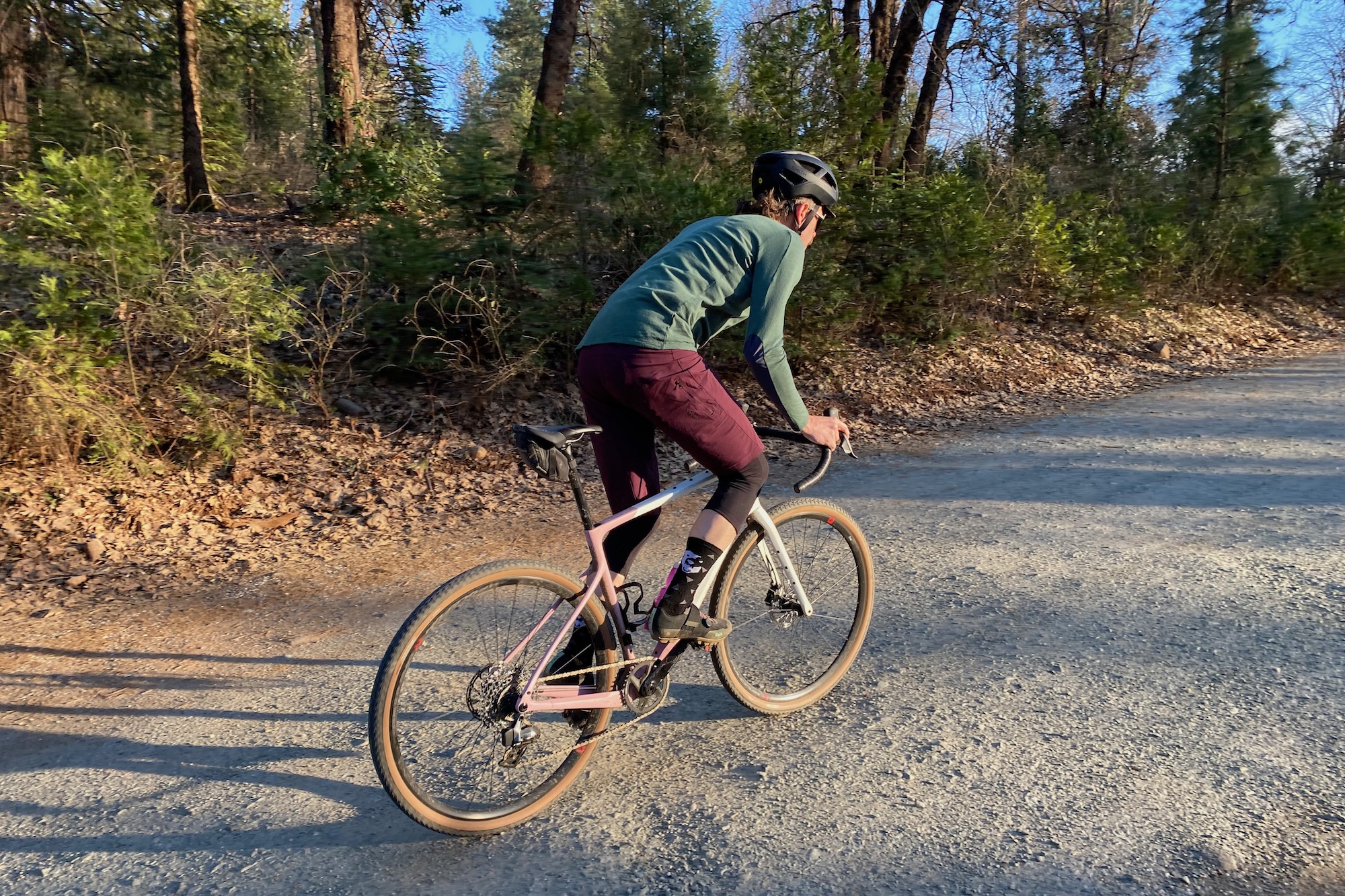
Buying Guide: How to Choose a Gravel Bike
The gravel bike market has grown exponentially in recent years, and there are now more models to choose from than ever before. With frames made from carbon, aluminum, steel, and titanium, 700c and 650b wheels, and bikes designed for racing, bikepacking, and everything in between.
The sheer number of options is enough to make your head spin. To help cut through the chatter, we’ve outlined many of the important factors to consider when searching for your next gravel bike.
Where and How Do You Ride?
Before you open up your wallet, reflect on where and how you ride. It’s the single most important indicator to consider when choosing any bike. Are you a high-performance racer looking for the fastest bike you can find or are you gravel-curious and interested in seeing what this whole gravel riding thing is about? Maybe you’re somewhere in between?
Some gravel bikes are impressively versatile and work well across the spectrum of gravel styles. Bikes like the Specialized Diverge and the Ari Shafer are excellent all-rounders that work pretty darn well in just about any situation, from weekend races to bikepacking adventures.
Others are a bit more specific in their design and intention. The Ventum GS1 is a good example. This lightweight bike has a race-oriented geometry that prioritizes speed over comfort and versatility. On the other end of the spectrum, the Ritchey Outback is a steel-framed bike that’s long, stable, and ready to take on the most adventurous bikepacking routes and tours that you can dream up.
Size
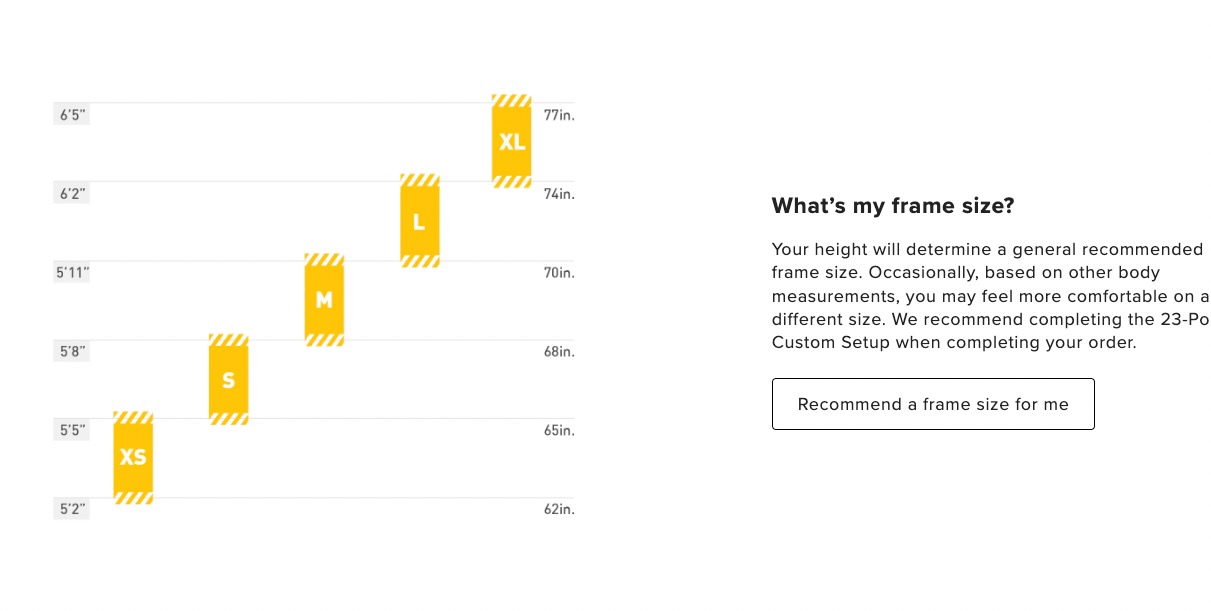
Buying the right size bike is a very important first step in the process, but interpreting the data on a geometry table can be like reading the Mars Rover launch code. If you already know your mountain bike or road bike size, chances are that you’ll probably ride the same-sized gravel bike. To cut to the chase, most companies will include rider height charts to steer you toward your frame size.
If you don’t know your size, find your ideal top tube length (the length between the center of the head tube and the seat tube on the horizon — also called the effective top tube or ETT). You may already have this number from another bike you’ve ridden.
There are a few calculations online to help find this number, or you can get sized up at a local shop. Because of gravel’s road pedigree, a lot of these measurements will be in metric. Many bike manufacturers allow you to toggle between metric and imperial on their online geometry charts.
Most top tube measurements put you on the same frame size between different brands, but it’s important to double-check because that isn’t always the case. If you are between sizes, you’ll have the option to size up or down. Smaller will give you a sportier ride, while larger offers more stable performance. Changing your seat and cleat position can dial in your fit, and swapping stems is an inexpensive way to adjust the fit of your cockpit.
Geometry
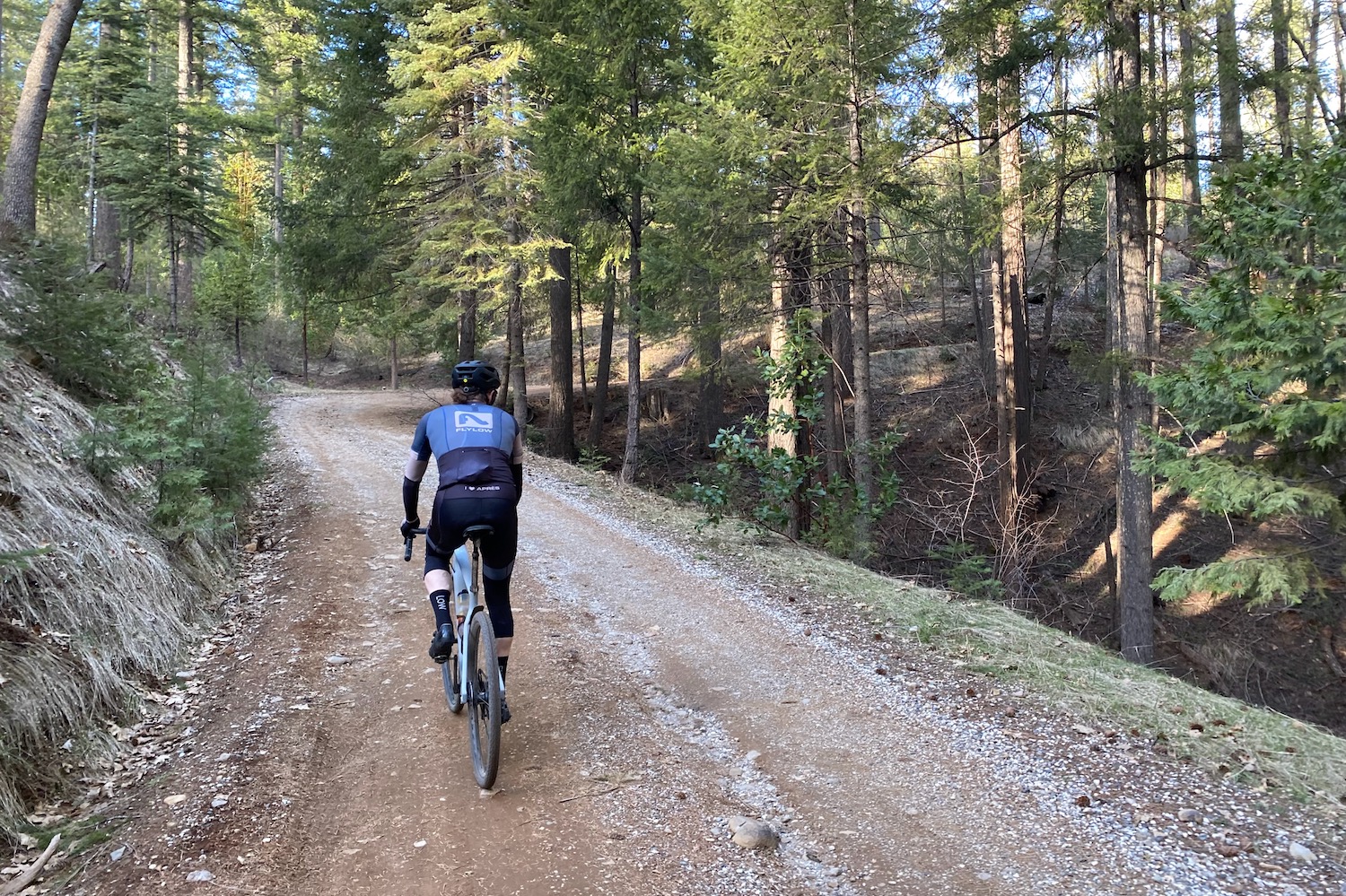
In general, a gravel bike’s geometry is similar to a road bike but with more relaxed angles that help to make it more comfortable for riding off-pavement. There are many variations, of course, that help to define the way a bike handles and performs when the rubber hits the dirt.
Dig a little deeper, and you can start to decipher how a bike’s geometry impacts handling. Longer chainstays (or “rear to center” measurements) can feel more flexy and stable on longer rides. However, shorter chainstays typically feel stiffer, snappier, and more nimble.
Oversimplifying it, a longer wheelbase provides greater stability at speed but may impact a bike’s handling in tighter turns. A shorter wheelbase will feel stiffer and will be more responsive, but possibly at the cost of slight reduction in high-speed stability. These numbers aren’t the end-all. Components and other geometry measurements will also play a significant role in how the bike handles.
Linking the fork to the bike, the head tube length, and the angle will also affect the ride and handling. Shorter head tubes generally put the rider in a more aggressive (racing) stance, while longer head tubes push the rider more upright and into a relaxed position.
A steeper head tube angle will continue to make the bike feel more racy and responsive, while a “slacker” angle will provide more stability but may require more effort to steer the bike. Riders frequenting steeper and rougher terrain will generally benefit from a more relaxed head tube angle.
On the front end, a fork’s rake (or offset) measures the hub’s offset from the steering axis. A longer trail (the tire’s footprint “trailing” behind the hub’s axis) implies more stability, whereas a shorter trail will make the bike feel more lively.
Frame Material
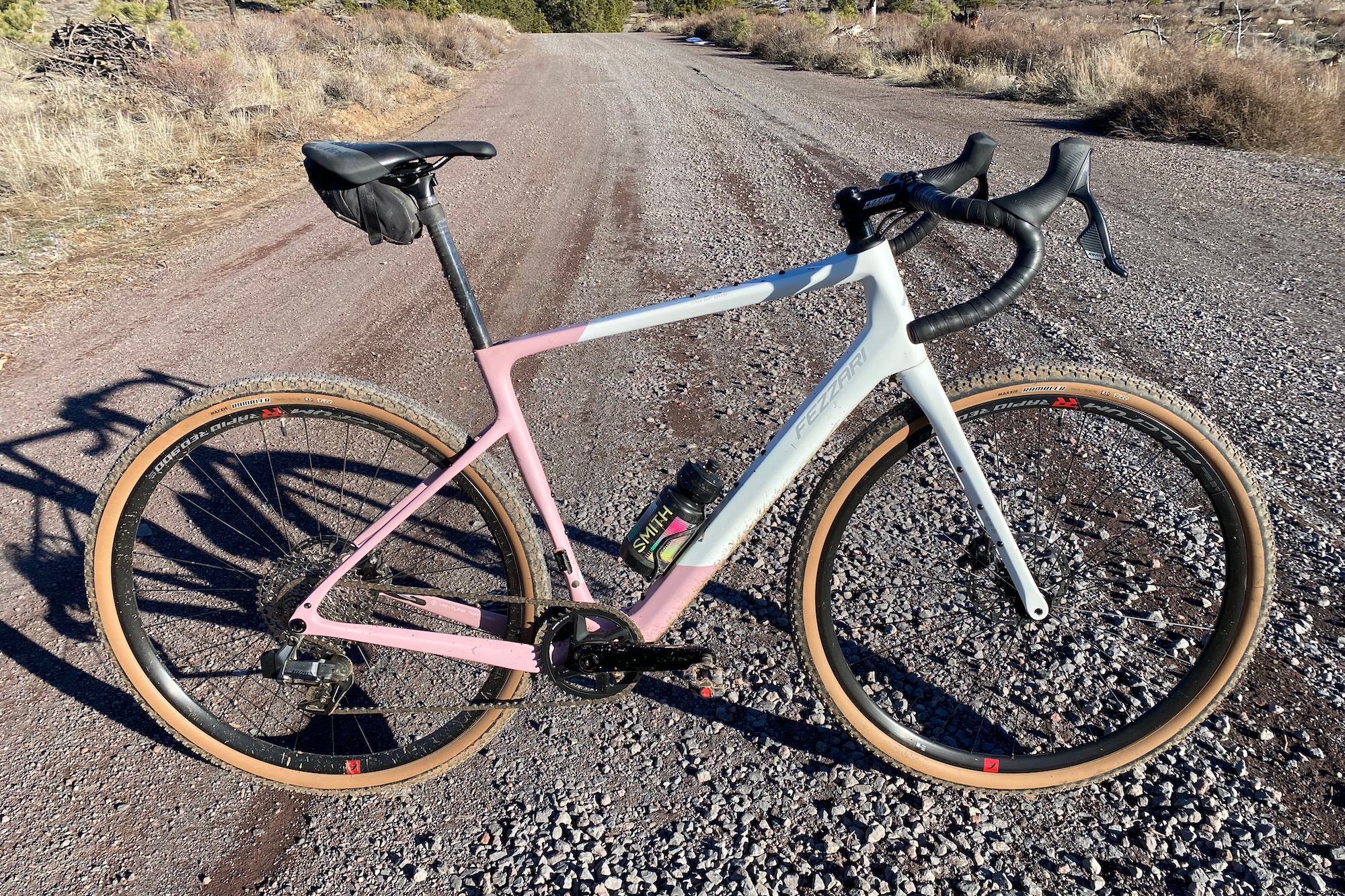
The frame material is one of the main differentiating factors in modern gravel bikes. Carbon fiber and aluminum are by far the most common materials used in the construction of gravel frames. Steel and Titanium are less common, but there are quite a few options if you look around.
Carbon fiber typically commands a higher price because the material, molds, and process are simply more costly. That said, it is generally the material of choice for most performance-oriented riders. Carbon frames typically weigh less, and the material can be manipulated in a variety of ways during the layup process to achieve desired characteristics. The tiny interfaces in the carbon structure also work well to absorb high-frequency vibration, which can help enhance comfort.
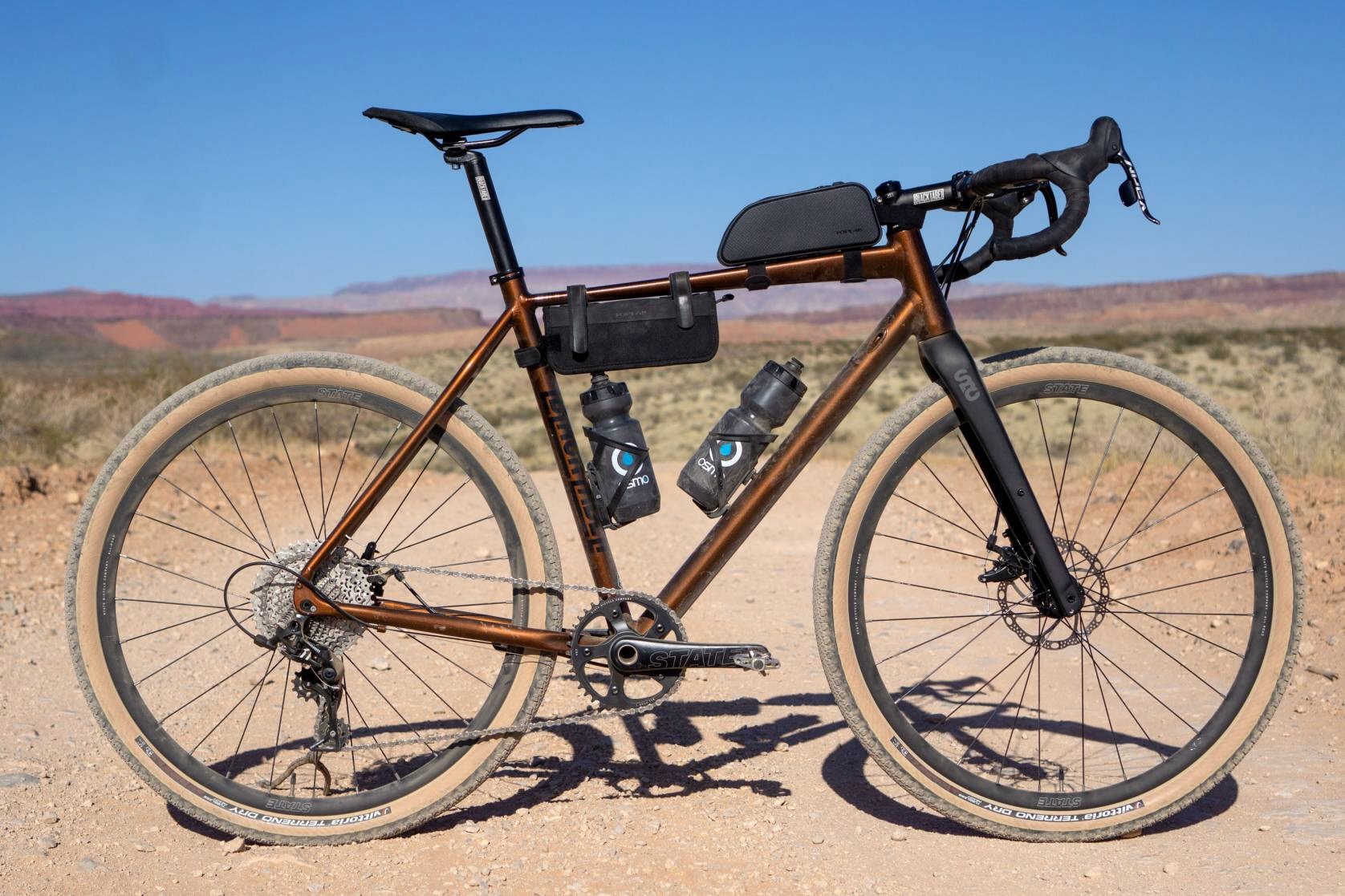
Aluminum is more affordable as a raw material and the production costs are comparatively lower, so aluminum frames are generally much cheaper than carbon. Aluminum also happens to be lighter than steel. It can’t be manipulated in quite the same ways as carbon fiber, so it often has a bit stiffer of a ride quality. To combat this, many aluminum frames come with carbon forks. These days, many brands produce aluminum versions of their carbon bikes, which are typically sold at a lower price point for more budget-minded consumers.
Steel is a bit heavier than aluminum or carbon, but it has a distinctive ride quality that many purists appreciate. Steel also happens to be fairly inexpensive, although some boutique steel frames can still command a pretty penny. Titanium is lighter than steel and has an even more forgiving ride feel. Titanium also happens to be quite a bit more expensive.
Wheel Size
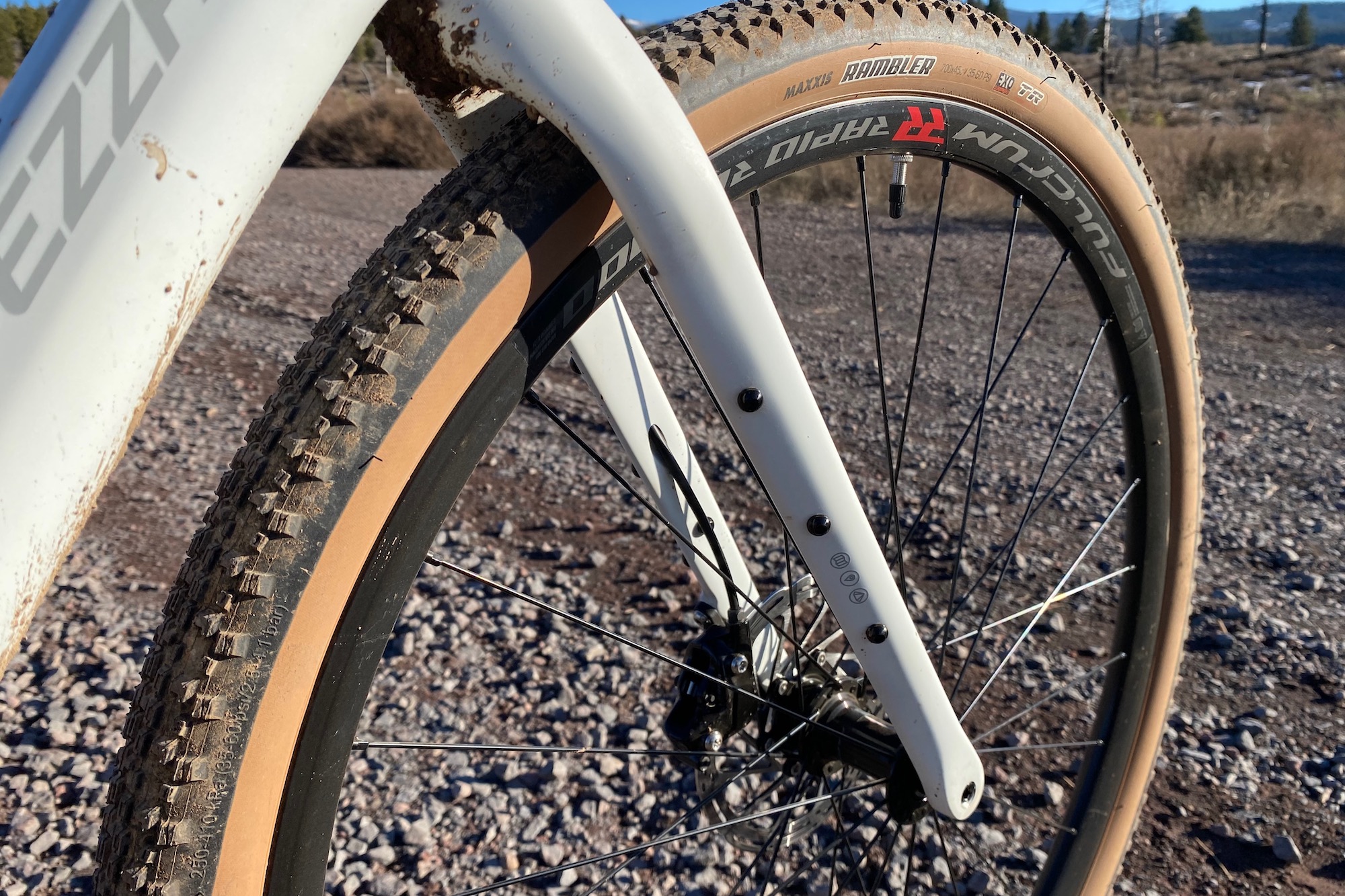
Gravel bikes draw influence from both the road and the mountain. Nowhere is this more clear than with wheels. Available in both road (700c) and mountain (650b) diameters, these numbers indicate the rims’ outside diameter (measured in mm). Plus, 650b is also synonymous with 27.5 inches, a common tire diameter used on mountain bikes. Many modern gravel bikes can work with either wheel size, and some even give the option to choose between the two at the time of purchase or you can switch somewhere down the line.
Generally speaking, 700c wheels roll over things a little more easily and carry speed a bit better. They can also run a narrower tire, giving the bike a smaller footprint on the ground. This reduces surface friction and provided the geometry supports it, you can convert your gravel bike into a capable road bike.
Most modern gravel bikes have increased their tire clearance in recent years, so it’s possible to run tires up to 45 to 50 mm wide or as narrow as 30 mm. This gives you the option to choose the right tires to suit your preferences or the conditions.
700c wheels and tires are great when you want to go fast, but they reach a point of diminishing returns when you need more traction (and more forgiveness in the rough). And this is the true benefit of the 650b. It gives you the option to wrap the wheel with a capable, grippy 27.5 mountain bike tire for more grip and greater air volume and cushioning over chunky surfaces.
Tire diameters are marked clearly on the tire’s sidewall, followed by a second number measuring the tire’s width. So 700 x 45c (an excellent choice and our preferred diameter for 700c wheels) implies the tire measures 700 mm in diameter with 45 mm in width. Similarly, a 27.5 x 2.1 measures a 27.5-inch diameter with a 2.1-inch tire width.
Tires
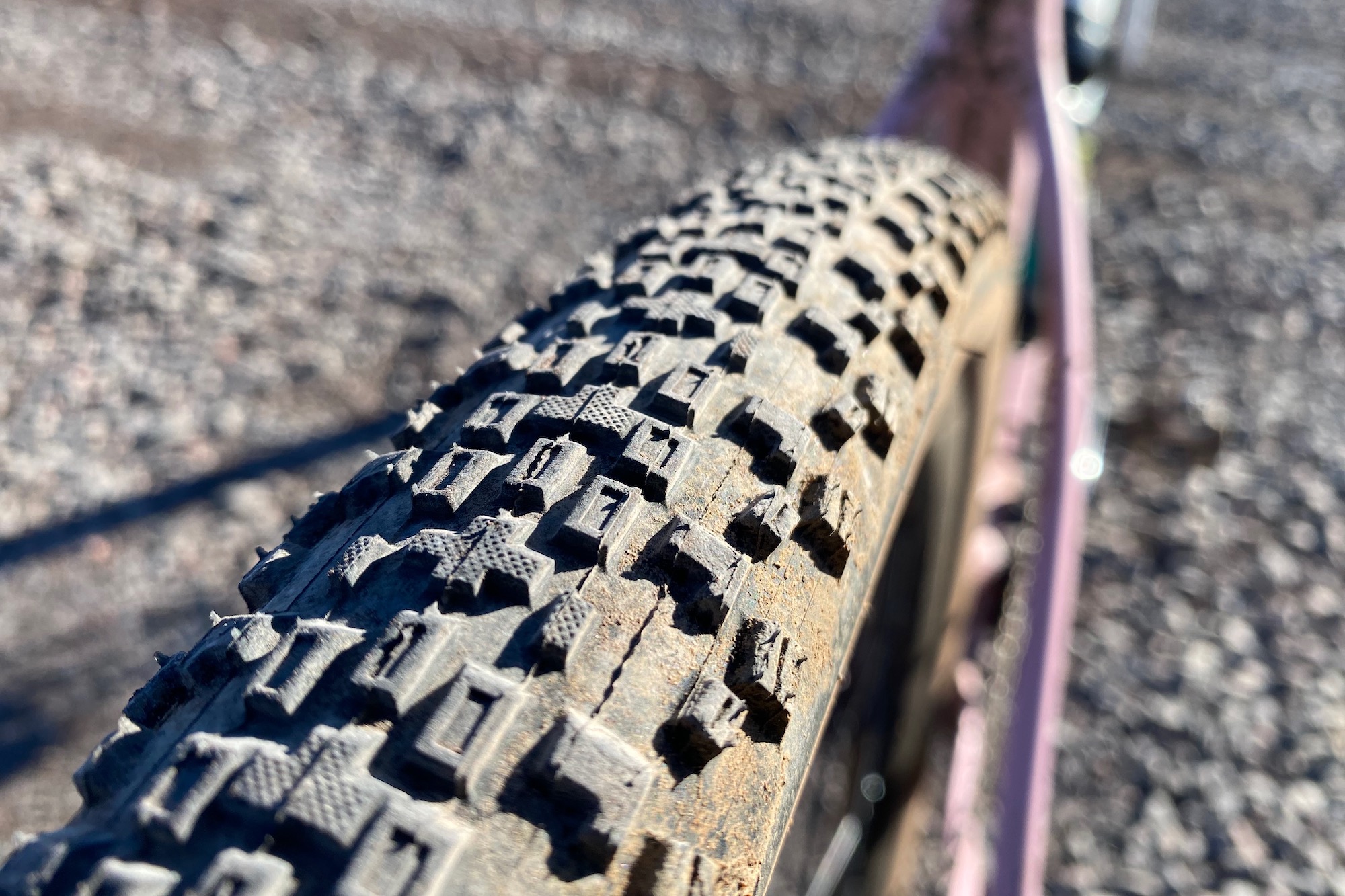
Let the conditions you ride be your north star. Select a tire with traction that matches your terrain. Outside a bike’s geometry and fit, tires are the best and most affordable way to improve your ride. Just like gravel bikes, there are literally hundreds of gravel bike tires to choose from so you can optimize your ride for the conditions you encounter most often.
Tread designs vary from super low-profile options optimized for speed on smooth hardpack to knobbier patterns for traction in loose or muddy conditions. We’re big fans of all-around tires that roll fast and work well in most conditions.
Along with tread designs, gravel tires come in a huge range of widths as well. This way, you can choose the width that works best for the conditions you’ll be riding or optimize your ride for speed or comfort. When choosing tires, however, you’ll need to consider your frame and fork’s clearance. Clearance is the amount of space between the fork, stays, and tubes on the bike’s frame.
In some cases, the stays provide enough room to run either wheel size. You always want to leave room between the tire and frame, especially if you ride in muddy conditions, where muck can collect and cement between the wheel and frame.
Tires must match the wheel size, of course. You can’t simply wrap a 650b tire on a 700c wheel. Fortunately, tires are available in a variety of widths and treads for both wheel sizes, providing great options for every bike. If you decide to run wider tires, it’s a good idea to use a rim that can manage your tire’s girth.
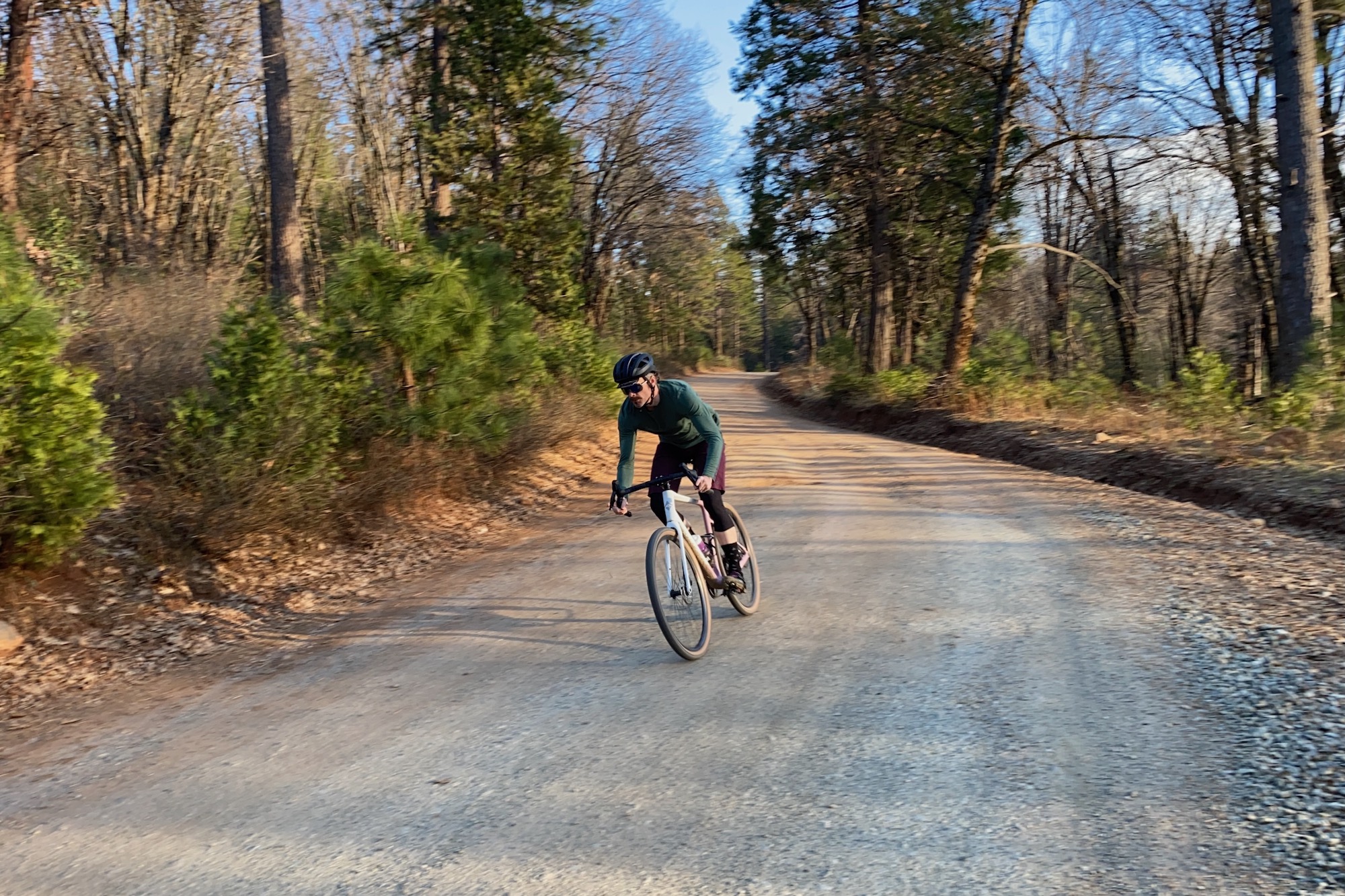
Regardless of tire size, if there’s one thing we learned while testing bikes, it’s that tire pressure truly matters. Most modern gravel tires are designed and intended to be run at lower pressures which absorb impact more readily, increase the tire’s contact patch, and improve traction and comfort.
To that end, running tires as tubeless is safer and lighter assuming your tires and rims are capable of doing so. Tubes pop more easily than the casings of tires and the tubeless sealant will typically close tiny punctures from goat heads or road debris. Always bring a repair kit with a tire plug and a new spare tube (rubber ages and can deteriorate over a year). And don’t forget a CO2 inflation kit or a hand-held bike pump.
Periodically check your tires for wear and tear. Gravel and sand act like sandpaper on tires, dulling the sharp edges of the tread. When a tire shows wear, it’s time to upgrade. Cutting corners by swapping your rear and front tires won’t cut it. In fact, your front tire should always have better traction. It provides confidence as you initiate corners and turns.
Components
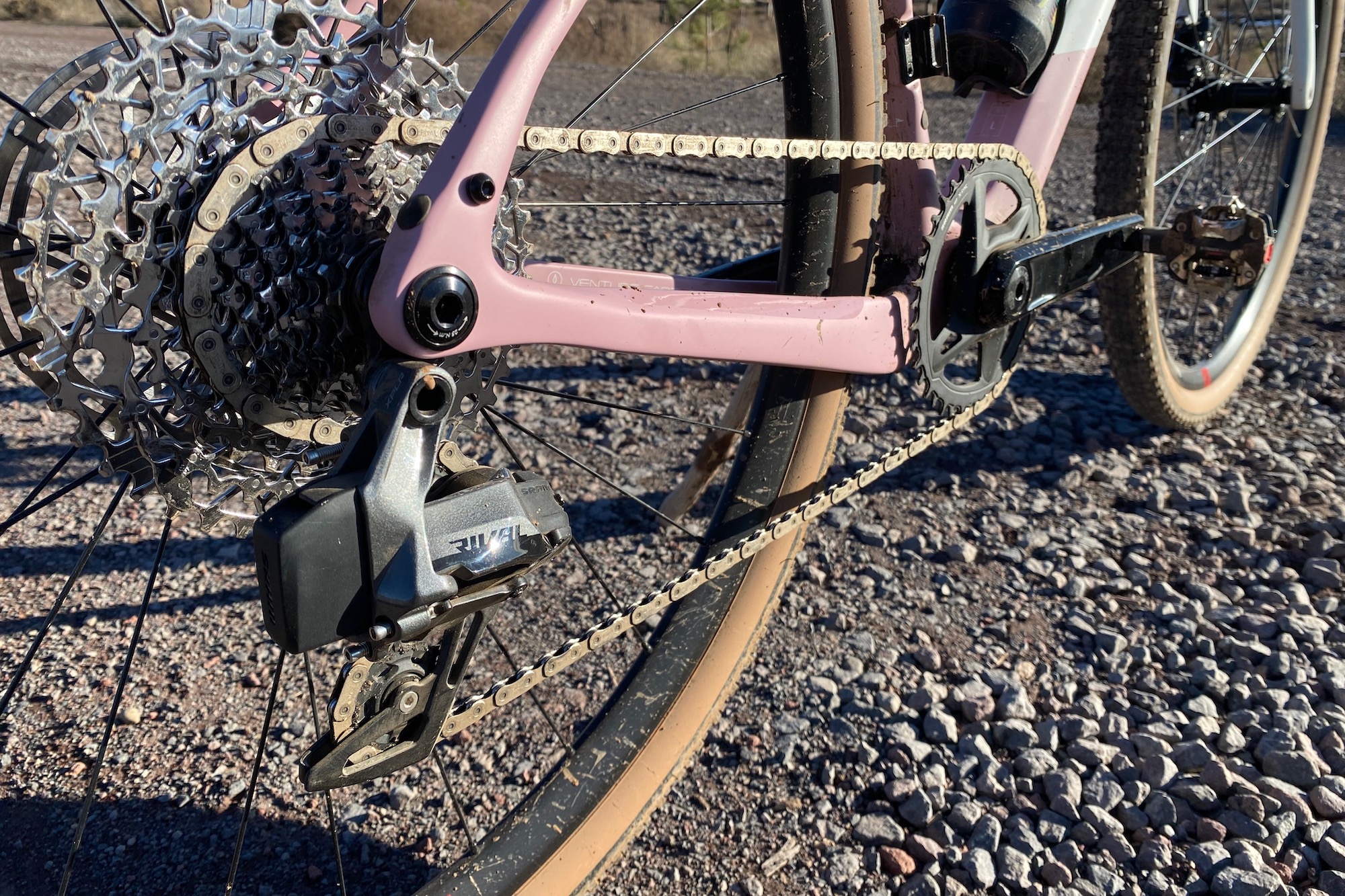
Like any other genre of cycling, we’ve got a lot of choices when it comes to the components we choose for gravel riding. While many early gravel bikes relied on road bike drivetrains and brakes — and many still do — both SRAM and Shimano have developed gravel-specific components to meet the growing and different demands of gravel riding. Some brands also offer mountain bike drivetrain components on their gravel bikes, as the two types of riding have similar demands.
When purchasing a new bike, you’re often given a choice of complete builds with component groupings correlating to price. As with both road and mountain biking, there are performance/price tiers for componentry, with higher-performance components commanding a higher price and vice versa.
For example, the Ari Shafer is offered in five complete builds ranging from $2,599 up to $4,999. They also provide upgrade options for things like wheels, so you can boost the performance of your bike right out of the box.
Ultimately, it’s up to you to decide if paying more for a desired build is worth it. For more experienced riders who demand a high level of performance day to day, it may make sense to spend more. Riders just getting into the sport or are more casual may not notice or care about the slight weight or performance differences. Even then, you’ve got the option to upgrade down the line should your needs or preferences change.
It’s also very important to consider things like the handlebar, handlebar tape, and saddle in the equation. These are places where our bodies make contact with the bike and can play a large role in our comfort and handling. Handlebars for gravel tend to be a bit wider and are often flared in the drops to provide more comfort and steering leverage for navigating rough terrain. Likewise, handlebar tape for gravel riding is often slightly thicker to provide more cushion and damping.
Saddles may also have more cushioning or shapes specifically geared towards riding on rough roads. Like anything else, it all comes down to preference and what works best for you. These parts are also less expensive to swap out when in search of the perfect setup.
Suspension and Dropper Posts
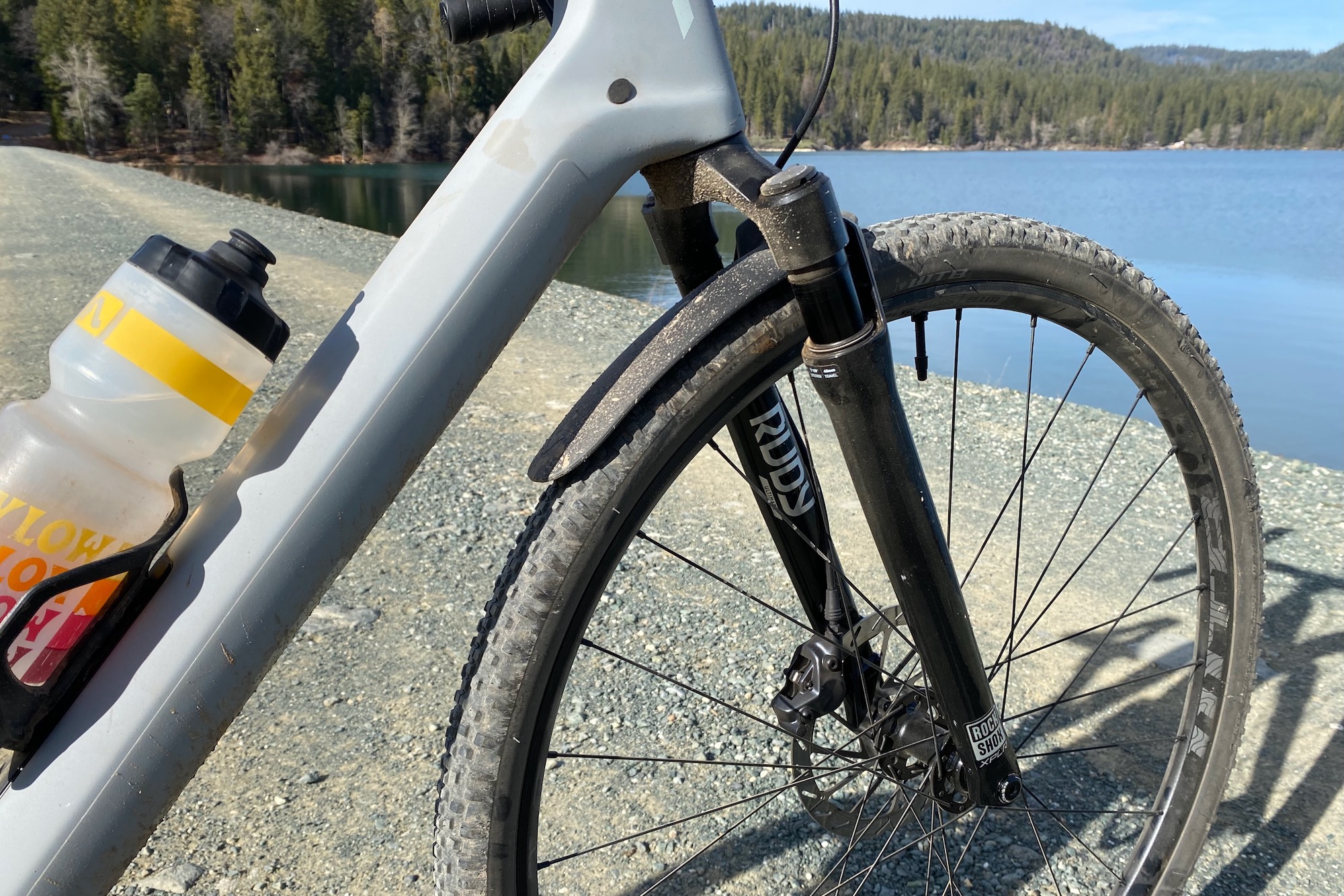
For truly rough conditions, a few brands offer bikes with 20-30 mm of suspension in the fork. Don’t expect to huck jumps at the local bike park. Rather, it’s just enough suspension to take the edge off of the chatter and add a little more comfort and control over rougher surfaces. It can help your hands stay fresher and reduce fatigue in your arms, shoulders, and upper body while helping your front tire maintain better traction.
Specialized has a suspension system integrated inside the head tube that locks out (for climbs) and opens up 20 mm of suspension for rough descents. RockShox, Fox, and Cane Creek all make gravel-specific suspension forks that can be purchased separately and used on many modern gravel frames. The YT Szepter Core 4 comes equipped with a RockShox Rudy XPLR fork that provides 40mm of travel. Canyon, Santa Cruz, and other brands also sell complete bikes that come with suspension forks.
While many gravel bikes offer narrow-diameter seat posts that allow a touch of extra flex, a few, like YT, Kona, and others, come with dropper posts. Is it worth the added weight? It very well can be if you find yourself descending steep, rocky roads, or you can’t help yourself from riding on singletrack trails.
A dropper can elevate your gravel game to superhero status, allowing you to tackle routes with your mountain bike buddies. That said, dropper posts on gravel bikes are overkill for most riders and the conditions you’ll encounter most frequently.
Accessories and Mounts
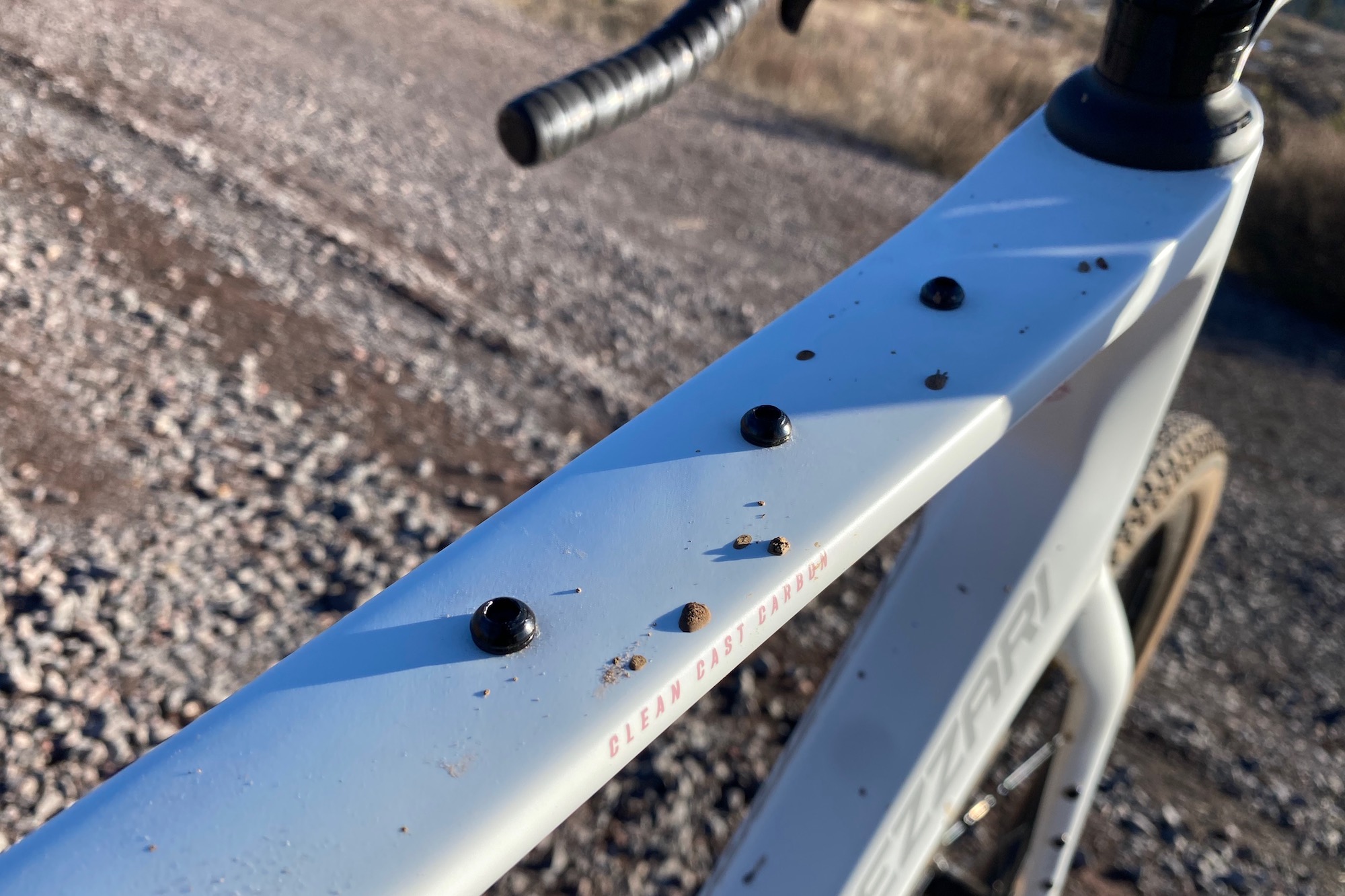
Gravel riding doesn’t require any uniquely special gear. You’ll need the same tools and riding gear you might already have for road or mountain biking. These tools include a portable tool kit with fittings that match the bike’s bolts, a pump or inflation kit, a spare tube, a seat or top tube bag to put it all in, and the knowledge of how to change a tire. Mount a water bottle cage (or two), bring a map or device to find your way home, and get rolling.
In recent years, many shoe brands have begun to develop gravel-specific shoes, though they are very similar to cross-country mountain bike shoes. Of course, you’ll also want to wear some well-fitting cycling shorts, a protective helmet to keep your head safe, and proper cycling eyewear so you can see the road, or trail, ahead clearly.
Since gravel bikes are super versatile, many people choose to use them for bikepacking and touring. Brands recognize this, and many add a wealth of braze-ons, or threaded mounts, to the frame to make it easier for folks to attach bags, racks, and bottles for extended adventures.
While braze-ons make it easier to attach things like rear racks or accessories on the fork, most gravel bikes have relatively traditional frame designs with open front triangles. This makes it easy to strap a frame pack inside, and handlebar bags and seat packs strap on as well.
FAQ
Gravel bikes are a relatively recent style of bike that has been optimized for use on gravel roads. For lack of a simpler explanation, they are a bit of a hybrid between road bikes and cross-country mountain bikes.
They borrow similar looks and frame designs from road bikes for low weight and efficiency and pull more relaxed geometry and larger tire clearance from mountain bikes for comfort and control over rough surfaces. Most, but not all, gravel bikes have drop handlebars like you find on a road bike and roll on wider, knobbier tires that provide enhanced grip and cushion on less perfect surfaces.
While they may look strikingly similar, gravel bikes and road bikes have some relatively significant differences. The most notable of these is increased tire clearance to accommodate wider and knobbier gravel tires. Most gravel bikes these days have clearance for tires up to 40 to 45 mm through the frame and 45 to 50 mm in the fork.
Gravel bikes also typically have geometries that have been adapted for off-road riding. This includes slacker head tube angles, taller stack heights, reach, and wheelbases that are optimized for comfort and control when riding on gravel. Of course, there are many variations of gravel geometry, with some bikes leaning towards racing, others towards comfort, and many falling in-between.
Additionally, the frames are often beefed up a bit in key areas to add durability and made more compliant in other areas for added comfort over rough surfaces. Many gravel bikes will also feature the addition of braze-ons and threaded mounts on the frame and fork to add accessories and bags for adventurous rides.
Need? No. Want? Maybe. It really comes down to your preferences and the terrain that you’re riding. Having ridden many different gravel bikes in the past few years, our testers have had the chance to try numerous gravel bikes with front suspension and a lot more without.
While it is certainly nice to have for rough, chunky roads or when taking your gravel bike into terrain where it probably shouldn’t go, it’s far from necessary for most people most of the time. If you take the time to consider the terrain and conditions you ride most often, and even the places you aspire to ride, you should be able to determine if it’s something you need. Some people ride smooth gravel, some people ride rough gravel, and some people ride chunky trails like they’re on a mountain bike.
Additionally, general comfort may be a deciding factor. If your hands and wrists go numb from vibration, a suspension fork may help reduce the frequency and severity of that happening. Another factor to consider is added weight. A suspension fork will add at least an additional pound of weight to your bike (possibly more) compared to a rigid carbon fork. Still, the added weight may be a reasonable tradeoff for the comfort and control that suspension can provide. Again, it’s up to you.
Of course, you can. Gravel bikes are similar to road bikes in many ways, but they have increased tire clearance, more relaxed geometries, and beefed-up frames to handle the rigors of off-pavement riding. For anyone looking to save a bit of money by not needing two different bikes — one for road and one for gravel — a gravel bike will work pretty well as a quiver of one.
While it may not be quite as light or zippy as a dedicated road bike, many high-end gravel bikes are pretty darn close. For pure road riding, however, you’ll benefit from swapping over to road bike tires for decreased rolling resistance. Many folks will even go so far as to purchase an additional road wheelset to make swaps between gravel and road modes quicker and easier.
Additionally, the slightly more relaxed geometry of many gravel bikes may make them a great commuter bike option. This way, you can hit trails, gravel roads, and pavement on the way to work without skipping a beat. Plus, you’ve got a bike for tackling gravel rides on the weekends, too.
Gravel bikes can be surprisingly capable and versatile. Most of them are plenty capable of riding smoother mountain bike trails under a skilled pilot when ridden with a little bit of caution. Some bikes are better suited for this than others, particularly those with more relaxed geometries, suspension forks, and dropper posts.
In fact, many modern gravel bikes are far more comfortable and capable than mountain bikes from the early 90s. It does take some skill to navigate more difficult trails safely, however, so it’s up to the rider to use their best judgment when deciding what to ride on their gravel bike.
Related Content
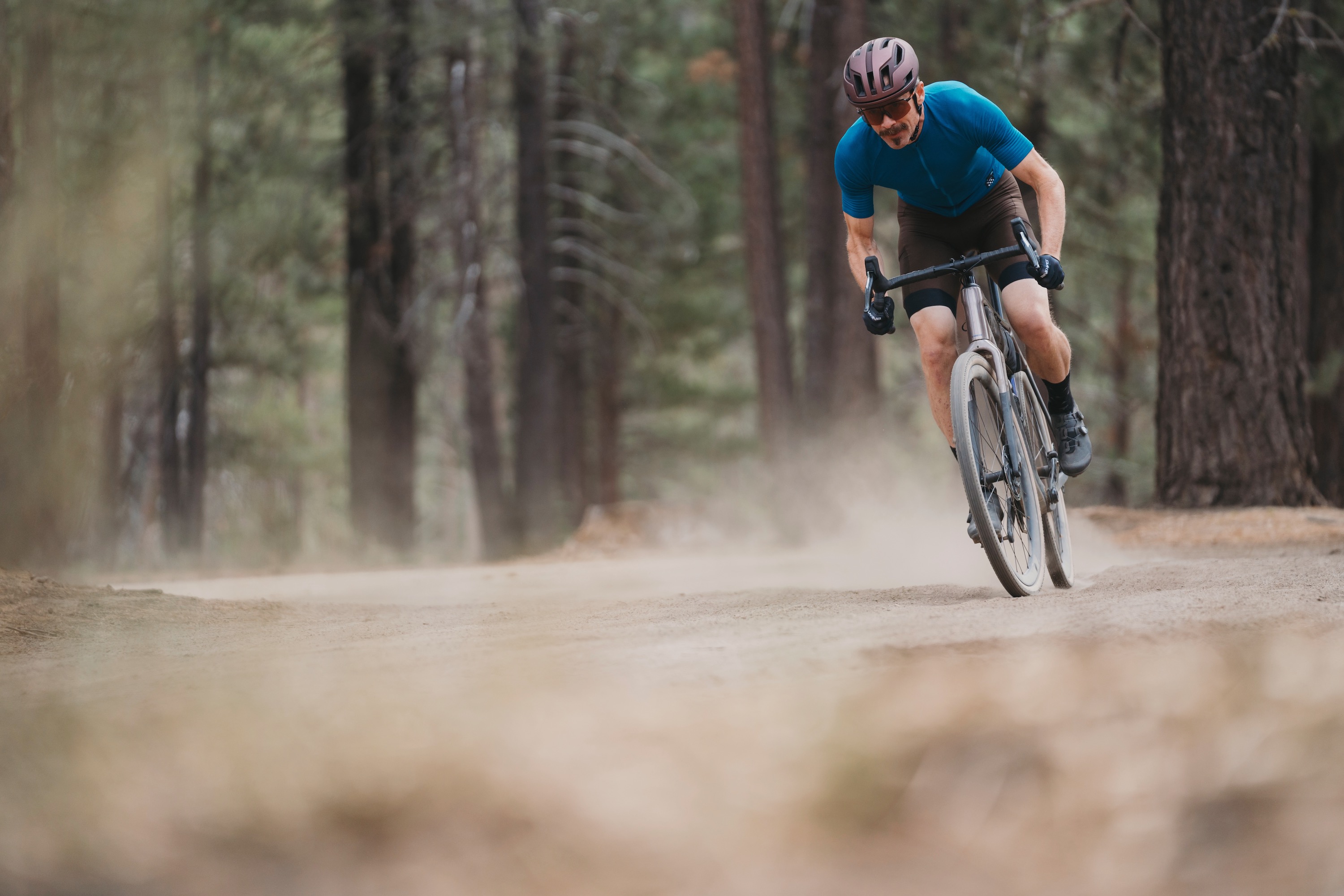
The Best Gravel Bike Shoes of 2025
We tested 13 models from top brands like Shimano, Fizik, Specialized, and more to find the best gravel bike shoes.
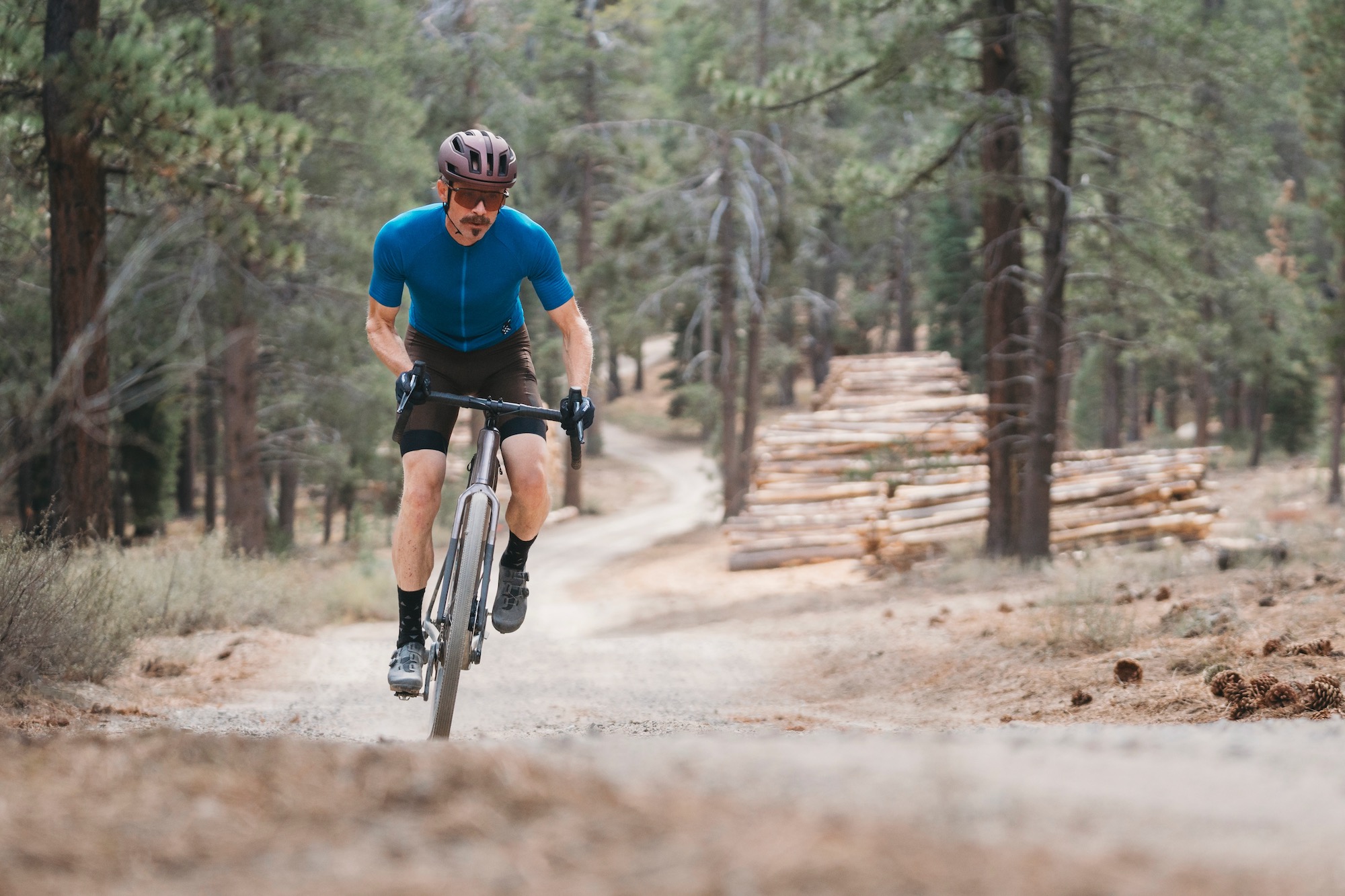
The Best Cycling Bibs of 2025
We tested 14 of the best men’s cycling bibs on the market to help you find the right pair for your perfect ride.

